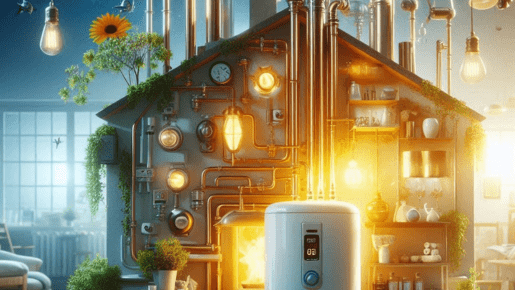
When it comes to household expenses, water heating often sneaks up as one of the biggest energy guzzlers. I’ve found that taking a few simple steps can make a huge difference in reducing those costs.
Whether you’re looking to save money or just be more eco-friendly, optimizing your water heating system is a great place to start. For comprehensive solutions, consider exploring expert water heater services to ensure your system is running efficiently.
Understanding Water Heating Costs
Effective management of water heating costs can significantly reduce household expenses. Knowing where these costs come from helps in finding ways to minimize them.
The Impact on Utility Bills
Water heating can account for up to 18% of a household’s utility bills, according to the U.S Department of Energy. Efficient water heating systems often mean lower monthly energy bills. Regular maintenance, like flushing the tank or insulating pipes, optimizes performance, resulting in cost savings.
Factors Affecting Water Heating Efficiency
Multiple factors impact water heating efficiency, including:
- Water Heater Type: Tankless heaters generally offer more efficiency compared to traditional storage tanks.
- Temperature Settings: Setting the thermostat to 120°F can reduce energy use without compromising comfort.
- Usage Habits: Shorter shower times and using cold water for laundry cut down on heating requirements.
- Insulation Quality: Adequate insulation around pipes and tanks prevents heat loss, ensuring the system uses less energy to maintain temperatures.
- Age of Water Heater: Older units tend to be less efficient. Replacing them with modern, energy-efficient models can lead to substantial savings.
Factoring in these elements when selecting and maintaining a water heater aids in maximizing energy efficiency and reducing costs.
Choosing the Right Water Heater
Selecting the right water heater is crucial for maximizing energy efficiency and reducing costs. Different types present unique advantages and challenges.
Types of Water Heaters
Several types of water heaters cater to various needs.
- Storage Tank Water Heaters: Store a large volume of hot water. Common but less energy-efficient due to standby heat loss. Frequent in homes where hot water demand fluctuates.
- Tankless (On-Demand) Water Heaters: Heat water only when needed. More energy-efficient as they eliminate standby heat loss. Ideal for homes with high, inconsistent water usage.
- Heat Pump Water Heaters: Use electricity to move heat from one place to another. Up to three times more efficient than conventional units. Best in warm climates with high hot water demand.
- Solar Water Heaters: Utilize solar energy. Highly environmentally friendly but depend on sunlight availability. Suited for sunny regions and eco-conscious households.
- Condensing Water Heaters: Use waste heat from natural gas to heat water. Very energy-efficient. Effective in homes using natural gas for heating.
Energy Star Ratings
Energy Star ratings indicate the energy efficiency of water heaters.
Energy Star-certified models meet strict efficiency criteria set by the U.S. Environmental Protection Agency. These models typically provide significant savings on utility bills. Look for units with a high Energy Factor (EF) rating, reflecting greater efficiency. For example, a standard gas water heater might have an EF of around 0.6, while an Energy Star model could exceed 0.75.
Selecting a water heater with a high Energy Star rating ensures optimal energy use and cost savings over the device’s lifespan.
Insulation Techniques
Efficient insulation can significantly reduce water heating costs by minimizing heat loss. Below are methods to enhance insulation.
Insulating Water Heater Tanks
Wrapping old water heater tanks with an insulating blanket reduces standby heat loss. Insulating blankets, available in hardware stores, come with R-values indicating thermal resistance. A higher R-value means better insulation. When installing, follow the manufacturer’s guidelines to avoid blocking the thermostat or drain valves.
Pipe Insulation
Insulating hot water pipes decreases heat loss in transit. Pre-slit foam pipe insulation is easy to install on accessible pipes. Focus on the first 6 feet from the water heater. Consider frost potential for outdoor pipes; ensure materials are weather-resistant. This simple step maintains higher water temperatures, reducing energy usage for reheating.
Temperature Adjustments
Adjusting your water heater’s temperature significantly reduces energy costs and improves overall efficiency.
Optimal Water Heater Settings
Setting your water heater to a lower temperature decreases energy consumption. The U.S. Department of Energy suggests keeping the thermostat at 120°F (49°C). This setting provides hot water for most household tasks while saving approximately 10% on water heating costs. Reducing the temperature also slows mineral buildup and corrosion in the heater and pipes, extending their lifespan. For families with multiple members, maintaining this temperature ensures an adequate hot water supply without unnecessary energy usage.
Safety Considerations
Lowering the water heater’s temperature enhances safety, particularly for children and the elderly. Hot water burns occur quickly, and setting the thermostat at 120°F (49°C) prevents scalding risks. Testing the water temperature at the faucet ensures it matches the heater setting; use a thermometer to verify this. Additionally, installing anti-scald devices at faucets or showerheads adds an extra layer of protection, maintaining both comfort and safety. Adjusting temperatures affect heater performance, so make incremental changes and monitor efficiency closely.
Maintenance Tips
Routine maintenance significantly enhances energy efficiency and extends the lifespan of water heaters. It also reduces long-term costs by preventing expensive repairs.
Regular Maintenance Routines
Flushing the tank every six months minimizes sediment buildup and improves heater efficiency. Draining a few gallons of water helps clear the sediments. Inspecting the temperature and pressure relief valve ensures proper functionality; it should release water when pressure gets too high. Checking the anode rod, which attracts corrosive elements, prevents tank rusting. Replace the rod every 3–5 years for optimal performance. Insulating the pipes connected to the water heater retains heat, reducing energy loss. Additionally, ensuring the thermostat setting remains at 120°F helps maintain energy efficiency.
Identifying Common Issues
Recognizing common problems early can prevent significant damage. Leaks around the tank often indicate faulty connections or valves. Inspect the area regularly to identify and fix leaks promptly. No hot water or insufficient heating might point to issues with the heating elements or thermostat. Evaluate these components for wear and replace as necessary. Odd noises, like popping or rumbling, signal excessive sediment buildup. If sounds persist after flushing, further professional inspection is needed. Regularly checking for these problems ensures better performance and energy efficiency.
Innovative Technologies
Enhancing water heating with innovative technologies can lead to substantial energy savings. Let’s explore how tankless water heaters and smart thermostats contribute to efficiency.
Tankless Water Heaters
Tankless water heaters, also called on-demand or instant water heaters, provide hot water only when needed. By eliminating standby heat loss associated with storage tanks, these units improve energy efficiency. According to the U.S. Department of Energy, tankless water heaters can be 24-34% more energy-efficient for homes that use less than 41 gallons of hot water daily. Installing multiple units for different applications, such as dishwashers or showerheads, enhances performance and energy savings. This approach ensures that each water point gets heated efficiently without unnecessary energy expenditure.
Smart Thermostats
Smart thermostats integrate advanced technology to manage water heating systems more effectively. These devices learn user habits and preferences to optimize energy usage. For instance, they adjust heating cycles according to daily routines, reducing energy consumption when hot water demand is low. Integration with mobile apps enables remote control and monitoring, giving real-time insights into energy usage and cost. Many models provide detailed reports and suggestions for further improvements, making them a valuable addition to any energy-conscious household.



